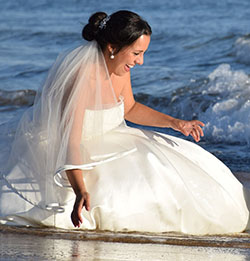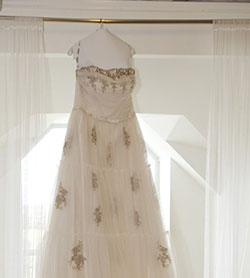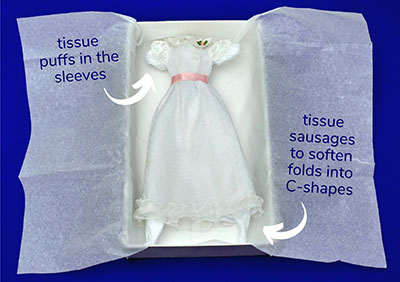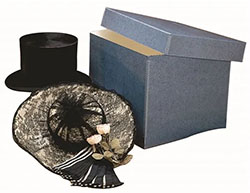Happily Ever After: Complete Guide on How to Store and Look After Your Wedding Dress
A guest post from objects conservator Jenny Mathiasson
 Love ‘em or hate ‘em, weddings are exceptional life events and often we want to keep something from them as a tangible memory of the day. Some people keep a slice of wedding cake, others dry the flowers from the bouquets or flower arrangements, and many of us hang on to the often focal garment of the occasion: the wedding dress.
Love ‘em or hate ‘em, weddings are exceptional life events and often we want to keep something from them as a tangible memory of the day. Some people keep a slice of wedding cake, others dry the flowers from the bouquets or flower arrangements, and many of us hang on to the often focal garment of the occasion: the wedding dress.
Whether you’re looking to keep your own wedding dress after the big day, or you’re wanting to keep a mother or grandmother’s old bridal gear safe for future generations, this blog entry will give you some ideas for long term storage that should help give it the longest possible life.
Keep it clean
Before storing your wedding dress (or any garment) you should always check that it’s clean first. If you have a modern day dress you may want to take it to a dry cleaners or seek advice from the shop you’ve purchased it from about how to best clean it. If you’ve got a vintage dress on your hands you’re best off taking it to a conservator: this can be a textile conservator or an objects conservator who regularly deals with costume. They’ll be able to clean it in a way that’s kind to the materials and considerate of its age. Modern detergents contain a lot of additives that may cause damage to older fabrics, and even specialist detergents used by conservators can’t be used with everything: for example
Orvus paste works well on cotton but can’t be used with silk, so tread carefully and seek advice if you’re at all unsure. Better safe than sorry, as they say!

Sometimes stains and dirt can be part of the memories: maybe you like that there’s mud along the bottom because it tells a story of how you had to switch your high heels for wellies during the reception, or that red wine splash is from when your father-in-law got so nervous he tipped his drink over you. In those cases you might opt not to clean those off, but just be aware that stains and dirt (or even just sweat) can attract pests who love munching on treasured textiles. Again a conservator can give you advice if you feel unsure of how to proceed.
Storage options
For something like a wedding dress you’ve got two main options for good storage:
- You can hang it, or
- You can store it in a box
So, which one should you choose? It’ll depend on what sort of dress design you’ve got: many wedding dresses are sleeveless or have sleeves and necklines that are made of a sheer material that isn’t exactly load bearing. Those dresses definitely go in a box as they’d struggle to support their weight otherwise. If in doubt it’s a good idea to choose the box option!

Letting it hang

If you’ve got a robust dress which isn’t too heavy you can opt for the hanging option: this is often the most economical in terms of space. Choosing a good clothes hanger is really important as wedding dresses are often a little heavier than your average party frock. A wooden one is a good idea, or a sturdy metal one (not a flimsy wire one). Avoid plastic at all costs as these fail spectacularly after a few years - I’ve had many snap on me!
Avoid clip hangers (as these crush the fabric over time and many have cushions that will age poorly) and try not to hang your wedding dress from the little internal clothing straps.
Next you’ll want to pad your hanger: a nice cushioned hanger is comfier for the dress longterm and supports it better as it spreads the weight across the shoulder area. You can wrap the hanger in polyester or cotton quilt batting until you’ve got a plump shape with no sharp edges and then you just need to cover it: a plain coloured cotton cut to size and sewn on does the trick! (I love colour but try to avoid bright colours in case something terrible happens: a burst pipe and running colours all over your dress wouldn’t be very nice!)
Don’t fancy sewing something yourself? No problem. You can buy pre-padded hanger covers made from the best materials here from PEL.
Once you’ve got your hanger you’ll want to get a bag to go around the dress to keep it free from dust and dirt, and to help discourage beasties from finding it (e.g. clothes moth). You can sew your own (there are many great patterns for costume bags out there on the internet) or purchase one ready made.
> | View Tyvek clothing bags here
Choose materials that last well: choose something like Tyvek or calico cotton, not plastic covers (they often disintegrate over time and aren’t as breathable which encourages condensation and mould). Again PEL sells good quality options for this if you’d like to save yourself some work.
Boxing clever
If your dress is sleeveless, fragile, or made of a lot of sheer materials you’ll want to choose the box option. Cardboard contains a lot of acids which age materials very fast, so treat yourself to a higher quality storage box if you can: an acid free and inert box will treat your dress like a queen!

An archival quality textile box, like the ones sold by PEL, is a good option because it won’t release any nasty chemicals onto your dress and it will keep it safe from light and dust. They come in a variety of sizes so you can choose one that works for you. A sturdy plastic box with a well sealed lid, like a large Really Useful Box, can also be a good alternative but these are often transparent which puts your dress at risk of unnecessary fading or light aging.
Whatever you choose, make sure it’s a box big enough to fit your dress without cramming, and that you can safely put a lid on it so nothing tries to get in (unless you’d like them to!). It should also be strong enough to take the weight of the garment. Line the box with acid free tissue paper and you’ll be ready to pop your dress in it!
> | View boxes for wedding dresses here
There’s a knack to placing the dress in the box too: any folds should be padded out so they’re more like C-shapes, to prevent creasing and harsh fold lines in the fabric. You can do this by making acid-free tissue sausages that you tuck in strategically. If you have the space it’s a nice idea to use tissue puffs to pad out the shape of puffed sleeves or bodices too, so the dress rests as if it was on a person. There’s a really great video on how to pack textiles in boxes here so you can see this demonstrated.
What about the veil?

Wedding dresses rarely come alone: often there are other important bits we’d like to keep with it, such as veils, garters, shoes, tiaras, and other accessories. Things like jewellery and shoes can go in archival quality boxes with some acid free tissue (heck, your best footwear can even go in
Tyvek shoe bags), but veils can be on the bulky side. Veils shouldn’t be crammed into a small container any more than a dress should, so you should choose a large box to gently place your veil in, and pack it in a similar way to your dress above so you don’t introduce harsh fold lines. Alternatively you could get an acid free tube, pad it with quilt batting and cover it with Tyvek or calico cotton, and gently roll the veil onto the tube (avoiding any creases!). Cover the veil-and-tube roll with a Tyvek or cotton sleeve and you’re done!
Where to pop it
The final thing to consider is where to store your dress and any accessories you’d like to go with it: this is more important than you might think. Textiles and costume last best when we keep them somewhere with a stable temperature and relative humidity, where they’re also protected from light exposure and pests looking for a meal.
That means a leaky attic, a damp basement, or the garage might not be the best place. Keep your packed up wedding dress away from sources of leaks or water and avoid external walls that get extra cold or damp.
Since we rarely have as much storage space as we’d like in our homes the spare room wardrobe or under the bed might be a good option as long as it fulfills the criteria above!
Good luck, and may you (and your dress) live happily ever after!
This guide was written by a qualified and experienced conservator! You can contact Jenny Mathiasson in the following ways:
E: jenny@kuriosa.co.uk | W: www.kuriosa.co.uk | T: @kuriosaltd | F: KuriosaConservation | I: @kuriosaltd